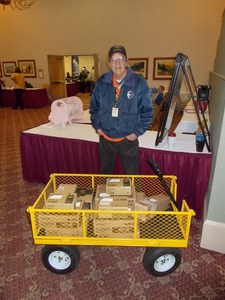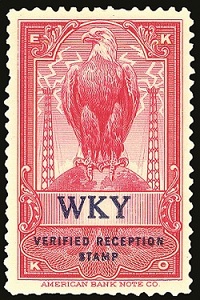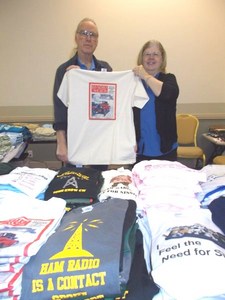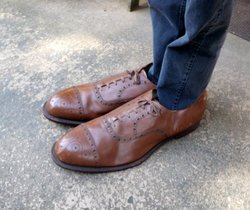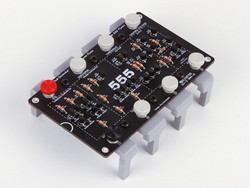 May 7, 2014 Editor: Ward Silver, NØAX | |||||||
IN THIS ISSUE
NEW HF OPERATORS - THINGS TO DO This weekend features a rarity in Amateur Radio - the ability to communicate with non-amateur stations! The Armed Forces Communication Test features military stations like NAV and AIR transmitting on frequencies outside but near the ham bands and listening on frequencies inside the ham bands. Make QSO with your uniformed servicemen and women - but be sure to get your split-VFO settings correct! BULLETINS Hank W6SX reports that the trial run of weekly CWOps Tests was successful and, "The keys have voted. We will have CWops Tests every Wednesday/Thursday from here out." Another late change is that the UNDX Contest rules have changed - be sure to read the new rules before next weekend's contest. (Thanks, Ivan UN9LU) BUSTED QSOS Relatively gaffe-free, the previous issue contained nothing for this section. CONTEST SUMMARY Complete information for all contests follows the Conversation section May 10-11
May 17-18
In October 2009 artist Daniela de Paulis and Jan van Muijlwijk PA3FXB started pioneering a new application of moonbounce technology, called Visual Moonbounce, which allows sending images to the Moon and back, combining Radio Astronomy with Amateur Radio technologies. Called OPTICKS, the title is inspired by Newton's discoveries of the light spectrum, reflection and refraction. Similarly, the colors composing an image - converted into radio signals - are bounced off the Moon (reflected and refracted) by its surface during each live performance. The performance is introduced by live sounds of amateurs radio signals captured by the Dwingeloo antenna tracking the Moon. (From AMSAT News Bulletin ANS-124)
A proceedings CD for the 2014 Eastern VHF/UHF/Microwave Conference is now available. A table of contents is available on-line, as well. These proceedings are always full of good articles about our higher-frequency allocations for contesters, grid-chasers, ping jockeys, and experimenters alike. In his "A Ham's-Eye View" blog on the EDN website, Doug K1DG wraps up the successful reception by the Juno spacecraft of our very-QRS transmissions a few months ago. This coordinated effort was a good example of how hams can "do science" by working together in tight coordination. One of the goals of WRTC2014 is to promote ham radio and radiosport to people outside of the ham radio community. As WRTC2014 is mentioned in the press, the WRTC2014 committee will collect these stories and put them online for all to enjoy. The Dayton Hamvention is imminent - are you going? To help plan your weekend shopping, downloadable maps have been posted for both the indoor exhibitions and outdoor flea market spaces. I've got my most comfortable walking shoes ready for duty - how about you? While you're in Dayton, if you are taking a side trip to the U.S. Air Force Museum, check out the Research & Development Gallery which is located in a separate area from the main museum. Two other excellent opportunities for visiting hams are the Aviation Trail and the National Voice of America Museum station tours by the WC8VOA club. (Thanks, Daily DX and Eric K9GY)
What to do with those blown cartridge fuses? Isn't Mother's Day coming up? The contest and DX community has lost some of its aloha with the death of Lee Wical, KH6BZF. Using the colorful "bloomin' zipper flipper" phonetics, Lee was a beacon from Hawaii for many years - since 1955. Lee was also the propagation guru for several decades for many Amateur Radio and DX outlets, providing solar terrestrial forecasts and other bits of solar wisdom. Mahalo, Lee, and aloha. What does a hamfest look like in another dimension? Take a look at the annual Massachusetts Institute of Technology "Flea at MIT". Web Site of the Week - This month marks 50 years since the invention of BASIC at Dartmouth College, the simplified programming language that made computing accessible to everyone. A recent interview on NPR with Dan Rockmore, a Dartmouth professor provides some interesting tidbits on the history of this almost universal programming language. WORD TO THE WISE Recruit - not the noun, the verb! Every contester should keep their recruitment detectors tuned up to high sensitivity, waiting for an opportunity to show an acquaintance or visitor how much fun ham radio can be, especially our competitive side. Take a portable station to the park or sports complex and operate in one of the numerous contests active every weekend. Be sure to take plenty of handouts since you'll have a steady stream of folks stopping by to see what's going on. Then you change the verb into the noun! Perhaps you've heard an "anvil screamer"? I don't mean when the coyote runs off the cliff and vanishes into the valley below to raise a tiny puff of dust, but the sound of corona discharge caused by an approaching thunderstorm! Where's the ka-boom? There was supposed to be an earth-shattering ka-boom! (Thanks, Tom K1KI) Ham operators make appearances throughout this 1989 composition by Bruce Atchison in collaboration with Gene Kosowan. It's an interesting four minutes. (Thanks, Mark N5OT)
Henryk SMØJHF has written a piece about "The Godfather of Contesting in Sweden" Rainer SM2DMU. There are good photos of Rainier's station near the Gulf of Bothnia in those northern latitudes. (Thanks, Daily DX) Get yourself all spun up by these videos showing some Serious Motors being built. While they may not have a place in ham radio - unless you have a Really Big Crankup - our appreciation of fields makes these videos about dc motors and ac motors of special interest. (Thanks, Tim K3HX) Do you think your tower's a big one? Well, I bet it's not as big as this 300-plus foot wind turbine pylon! The finale of this issue's "how they do it" trio shows just how those big poles go up - and why they stay up. (Thanks, Bob N6TV) OK, which of you were just a little bit disappointed not to see your shack in this "most disastrous cable messes" compendium? (Thanks, Tim K3HX) A new blog post by CQ World Wide Director, Randy K5ZD announces that results for both modes of the 2013 CQ WW DX Contest are now available online. This was another high point for CQ WW with a record 7,443 entrants submitting logs! Te online database of scores has been updated, as well - there are a lot of ways to experience the CQ WW Contest on cqww.com. The results are also available on the CQ magazine website. An email with a link to the Log Checking Report has been sent to everyone who submitted a log for the CQ WW DX Contest CW 2013. If you didn't receive a report, check your spam folder, then send an email to questions@cqww.com and provide the call sign you used in the contest.The Log Checking Report includes a complete summary of how the final score was calculated and any errors or deductions that may have occurred. Another CQ WW blog post has some information on typical error rates. (Thanks, Randy K5ZD)
The 2014 JIDX CW contest logs received list has been receiving steady updates. Winners of the 2011 through 2013 contests can now receive downloadable certificates, too. (Thanks, Tack JE1CKA) Roger G3KMA has posted the results of the IOTA Marathon online, as well. OPERATING TIP Raise your grid awareness and memorize not only your 4-character grid square but all the way to the 6-character locator that pins down your exact location. The 6-character locator is precise enough to allow microwave and other narrow-lobe antennas to be aimed right at you. At microwave frequencies, accurate antenna aiming often makes the difference between making a QSO and hearing only noise. Whatever did happen to Fahnestock clips? Electronic Design author W5LEF (Louis Frenzel) asks the provocative question in a recent blog post titled "Cable and Connector Hell". I wonder if he saw the cable mess web page mentioned above? Gary K4FS contributed this link to a website that is a laundry list of various modules you can use to build something interesting and possibly RF-related. The author lists sources to acquire these modules as well as a brief description of them. It would be useful for a great club building activity or competition, too. The short article "Turn a Spreadsheet Into a Delta-Sigma Modulator" shows just how these common analog-to-digital converters work. As a bonus, author Dave Van Ess gives possibly the simplest description of Morse code ever. I didn't say it was useful, just the simplest!
Looking for cool way to get those "alternative power" Field Day bonus points? How about a bicycle-powered generator as in this Popular Mechanics article? Having just wrestled with this problem yesterday, I can certainly endorse the Savage GripLine, a tape measure that can hang on to round things - even up to 2-inch diameter things! Now who will invent one that on command from the other end lets go of whatever it has gripped. Trying to accurately (and safely) drill holes in round or irregularly-shaped objects can be quite a challenge. This Instructables project shows a way to do it by fashioning a custom jig with modeling clay to hold the object in place. This video shows a rather unusual way to power a digital isolator IC. Or a QRP rig. Who knows - with a little ham ingenuity we could even have vacuum tubers! (Thanks, Doug K1DG - he is not responsible for that bad pun) This website by VE2DBE uses topo map data, transmitter and receiver antenna height and gain, transmitter power, frequency (and a host of other factors) to generate color-coded maps for signal strength, that can be saved and linked to as an overlay to Google Maps. Just the thing for evaluating those Rover sites! Setting up a login is required but no personal information is needed and the price is right - free! (Thanks, Charlie, KX7L) I think we've all heard the story about holding your car keys to your head to get more range out of your wireless key fob. Here's how it really works! (Thanks, Brian K1BRF)
Need a manual for older Hewlett-Packard equipment? It just might be here in this online archive. (Thanks, Tom WØEAJ) This issue's magazine mailbag features a couple of interesting radio astronomy stories from the IEEE Antennas and Propagation Magazine.
Technical Web Site of the Week - Hams not only talked to the Juno spacecraft but were instrumental in advancing a new 1950s technology known as "slow scan TV." This story about recovering "lost" lunar photos originally transmitted back to Earth by an SSTV variation makes for a great "how dunnit." (Thanks, Bill Saltzstein) We're Goin' to Dayton Dayton has the same emotional attraction to hams as Graceland does to Elvis Presley fans. Thus, when Dr Beldar's muse whispered in his ear, "We're goin' to Dayton!" there was nothing else to do but get busy. Have fun with the doctor's re-tuning of "Graceland" by Paul Simon - there are plenty of online versions of the original to hum along with. Hope to see all of you "Free Hams in Dayton" being unfettered and alive in a couple of weeks! 73, Ward NØAX Dayton Misty Ohio river was shining She came back to another call I'm going to Dayton There is a ham from east Missouri In Dayton in Dayton May 7 through May 20 An expanded, downloadable version of QST's Contest Corral in PDF format is available. Check the sponsor's Web site for information on operating time restrictions and other instructions. HF CONTESTS Alessandro Volta RTTY DX Contest--Digital, from May 10, 1200Z to May 11, 1200Z. Bands (MHz): 3.5-28. Exchange: RST, serial, CQ zone. Logs due: May 31. Rules Armed Forces Comm'ns Test--Phone,Digital, from May 10, 1200Z to May 11, 2400Z. Bands (MHz): 1.8-28. See website for specific station schedules. Exchange: RS(T). Logs due: no logs. Rules CQ-M International DX Contest--Phone,CW, from May 10, 1200Z to May 11, 1200Z. Bands (MHz): 1.8-28. Exchange: RS(T) and serial. Logs due: 30 days. Rules Portuguese Navy Day--Phone,CW, from May 10, 1500Z to May 11, 1500Z. Bands (MHz): 3.5-28. Exchange: RS(T), serial, CQ zone. Logs due: 20 days. Rules Nevada Mustang Roundup--Phone,CW,Digital, from May 10, 1700Z to May 11, 1700Z. Bands (MHz): 1.8-28, 50. Exchange: RS(T) and S/P/C or NV county. Logs due: Jun 15. Rules FISTS Spring Sprint--CW, from May 10, 1700Z to May 10, 2100Z. Bands (MHz): 3.5-28. Exchange: RS(T), S/P/C, name, FISTS nr or power. Logs due: 30 days. Rules Straight Key Weekend Sprintathon--CW, from May 11, 1200Z to May 12, 2359Z. Bands (MHz): 1.8-28, 50. Exchange: RST, QTH, name, member nr if member. Logs due: 5 days. Rules CWops Monthly Mini-CWT Tests--CW, from May 14, 1300Z - See website. Multiple time periods. Bands (MHz): 1.8-28. Weekly on Wednesday (May-June only), 28 to 38 kHz above band edge. Exchange: Name, member number or S/P/C. Logs due: 2 days. Rules Portuguese Navy Day--Digital, from May 17, 0800Z to May 17, 1500Z. Bands (MHz): 3.5-28. Exchange: RST, serial, CQ zone. Logs due: 20 days. Rules His Majesty King of Spain Contest--CW, from May 17, 1200Z to May 18, 1200Z. Bands (MHz): 1.8-28. Exchange: RST and serial or EA province. Logs due: 15 days. Rules Feld-Hell Hamvention Sprint--Digital, from May 17, 1600Z - See website. Multiple time periods. Bands (MHz): 1.8-28. Monthly on 3rd Saturday. Exchange: RST, S/P/C, Feld-Hell member nr. Logs due: 7 days. Rules Baltic Contest--Phone,CW, from May 17, 2100Z to May 18, 0200Z. Bands (MHz): 3.5. Exchange: RS(T) and serial. Logs due: Jul 1. Rules Worked All Britain - 7 MHz Phone--Phone, from May 18, 1000Z to May 18, 1400Z. Bands (MHz): 7. Exchange: RS, serial, and WAB nr or DXCC entity. Logs due: 21 days. Rules Run For the Bacon--CW, from May 19, 0200Z to May 19, 0400Z. Bands (MHz): 1.8-28. Monthly on 3rd Sunday night (local). Exchange: RST, S/P/C, Flying Pig nr or power. Rules VHF+ CONTESTS 50 MHz Spring Sprint--Phone,CW,Digital, from May 10, 2300Z to May 11, 0300Z. Bands (MHz): 50. Exchange: Grid square (6-character preferred). Logs due: 14 days. Rules Nevada Mustang Roundup--Phone,CW,Digital, from May 10, 1700Z to May 11, 1700Z. Bands (MHz): 1.8-28, 50. Exchange: RS(T) and S/P/C or NV county. Logs due: Jun 15. Rules Straight Key Weekend Sprintathon--CW, from May 11, 1200Z to May 12, 2359Z. Bands (MHz): 1.8-28, 50. Exchange: RST, QTH, name, member nr if member. Logs due: 5 days. Rules LOG DUE DATES May 7 through May 20
ARRL Information Click here to advertise in this newsletter, space subject to availability. Your One-Stop Resource for Amateur Radio News and Information ARRL membership includes QST, Amateur Radio's most popular and informative journal, delivered to your mailbox each month. Subscribe to NCJ - the National Contest Journal. Published bimonthly, features articles by top contesters, letters, hints, statistics, scores, NA Sprint and QSO Parties. Subscribe to QEX - A Forum for Communications Experimenters. Published bimonthly, features technical articles, construction projects, columns and other items of interest to radio amateurs and communications professionals. Free of charge to ARRL members: Subscribe to The ARRL Letter (weekly digest of news and information), the ARES E-Letter (monthly public service and emergency communications news), Division and Section news -- and much more! ARRL offers a wide array of products to enhance your enjoyment of Amateur Radio. Visit the site often for new publications, specials and sales. Donate to the fund of your choice -- support programs not funded by member dues! Reprint permission can be obtained by sending email to permission@arrl.org with a description of the material and the reprint publication. ACKNOWLEDGEMENTS ARRL Contest Update wishes to acknowledge information from WA7BNM's Contest Calendar and SM3CER's Contest Calendar. | |||||||
